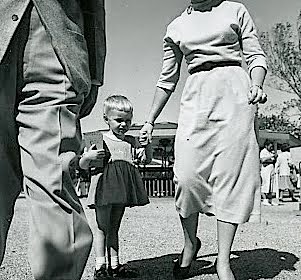
(Above, Freud and his daughter Sophie, whose son Ernst is the
fort / da spieler.)
In
Beyond the Pleasure Principle (1920), Sigmund Freud relates the story of a game his grandson invented at the age of one and a half, before he could speak many words. He used to throw small objects away from him, then say "o-o-o-o" with pleasure. He also took a wooden spool attached to a piece of string, and threw it over the edge of his cot, so that it disappeared. After saying "o-o-o-o," he would pull it back to himself and say, "da." He repeated this game over and over. Freud and the boy’s mother understood him to be saying "
fort" and "
da" (German for "gone" and "there").
Freud theorized that this game of disappearance and return allowed the boy to manage his anxiety about the absences of his mother, to whom he was very attached. By controlling the actual presence and absence of an object, he was able to manage the virtual presence of his mother. The fort / da game was the child’s invention of symbolism: the use of one object (wooden reel) to represent another (mother).
If you recall our earlier discussion of language, you'll remember that Jacques Lacan discusses the important moment in the development of subjectivity when the child grasps the idea of language (the field of culturally symbolic sounds and representations) and so enters what he terms, "the symbolic order." In Lacan's reworking of Freud, language---symbolic representation---is the all important medium through which our access to "the real" is structured.
Freud's grandson was using his creative play as a way to deal with a basic childhood anxiety through representation. He was asserting control over his environment, learning a method to dispel anxiety and frustration and coming to terms with a concept: absence and presence, the idea that mother can be "gone" yet still there, in memory and play.
Here is the relevant section from
Beyond the Pleasure Principle:
"…At this point I propose to leave the dark and dismal subject of the traumatic neurosis and pass on to examine the method of working employed by the mental apparatus in one of its earliest normal activities. I mean in children's play.
The different theories of children's play have only recently been summarized and discussed from the psychoanalytic point of view by Pfeifer (1919), to whose paper I would refer my readers. These theories attempt to discover the motives which lead children to play, but they fail to bring into the foreground the economic motive, the consideration of the yield of pleasure involved. Without wishing to include the whole field covered by these phenomena, I have been able, through a chance opportunity which presented itself, to throw some light upon the first game played by a little boy of one and a half and invented by himself. It was more than a mere fleeting observation, for I lived under the same roof as the child and his parents for some weeks, and it was some time before I discovered the meaning of the puzzling activity which he constantly repeated.
The child was not at all precocious in his intellectual development. At the age of one and a half he could say only a few comprehensible words; he could also make use of a number of sounds which expressed a meaning intelligible to those around him. He was, however, on good terms with his parents and their one servant-girl, and tributes were paid to his being a 'good boy'. He did not disturb his parents at night, he conscientiously obeyed orders not to touch certain things or go into certain rooms, and above all he never cried when his mother left him for a few hours. At the same time, he was greatly attached to his mother, who had not only fed him herself but had also looked after him without any outside help. This good little boy, however, had an occasional disturbing habit of taking any small objects he could get hold of and throwing them away from him into a corner, under the bed, and so on, so that hunting for his toys and picking them up was often quite a business. As he did this he gave vent to a loud, long-drawn-out '
o-o-o-o', accompanied by an expression of interest and satisfaction. His mother and the writer of the present account were agreed in thinking that this was not a mere interjection but represented the German word '
fort' ['gone']. I eventually realized that it was a game and that the only use he made of any of his toys was to play 'gone' with them. One day I made an observation which confirmed my view. The child had a wooden reel with a piece of string tied round it. It never occurred to him to pull it along the floor behind him, for instance, and play at its being a carriage. What he did was to hold the reel by the string and very skillfully throw it over the edge of his curtained cot, so that it disappeared into it, at the same time uttering his expressive '
o-o-o-o'. He then pulled the reel out of the cot again by the string and hailed its reappearance with a joyful '
da' ['there']. This, then, was the complete game of disappearance and return. As a rule one only witnessed its first act, which was repeated untiringly as a game in itself, though there is no doubt that the greater pleasure was attached to the second act. (1)
The interpretation of the game then became obvious. It was related to the child's great cultural achievement: the instinctual renunciation (that is, the renunciation of instinctual satisfaction) which he had made in allowing his mother to go away without protesting He compensated himself for this, as it were, by himself staging the disappearance and return of the objects within his reach. It is of course a matter of indifference from the point of view of judging the effective nature of the game whether the child invented it himself or took it over on some outside suggestion. Our interest is directed to another point. The child cannot possibly have felt his mother's departure as something agreeable or even indifferent. How then does his repetition of this distressing experience as a game fit in with the pleasure principle? It may perhaps be said in reply that her departure had to be enacted as a necessary preliminary to her joyful return, and that it was in the latter that lay the true purpose of the game. But against this must be counted the observed fact that the first act, that of departure, was staged as a game in itself and far more frequently than the episode in its entirety, with its pleasurable ending.
No certain decision can be reached from the analysis of a single case like this. On an unprejudiced view one gets an impression that the child turned his experience into a game from another motive. At the outset he was in a passive situation, he was overpowered by the experience; but, by repeating it, unpleasurable though it was, as a game, he took on an active part. These efforts might be put down to an instinct for mastery that was acting independently of whether the memory was in itself pleasurable or not. But still another interpretation may be attempted. Throwing away the object so that it was 'gone' might satisfy an impulse of the child's, which was suppressed in his actual life, to revenge himself on his mother for going away from him. In that case it would have a defiant meaning: 'All right, then, go away! I don't need you. I'm sending you away myself.' A year later, the same boy whom I had observed at his first game used to take a toy, if he was angry with it, and throw it on the floor, exclaiming: '
Go to the fwont!' He had heard at that time that his absent father was 'at the front', and was far from regretting his absence; on the contrary he made it quite clear that he had no desire to be disturbed in his sole possession of his mother. We know of other children who liked to express similar hostile impulses by throwing away objects instead of persons. We are therefore left in doubt as to whether the impulse to work over in the mind some overpowering experience so as to make oneself master of it can find expression as a primary event, and independently of the pleasure principle. For, in the case we have been discussing, the child may, after all, only have been able to repeat his unpleasant experience in play because the repetition carried along with it a yield of pleasure of another sort but none the less a direct one.
Nor shall we be helped in our hesitation between these two views by further considering children's play. It is clear that in their play children repeat everything that has made a great impression on them in real life, and that in doing so they
abreact the strength of the impression and, as one might put it, make themselves master of the situation. But on the other hand it is obvious that all their play is influenced by a wish that dominates them the whole time, the wish to be grown-up and to be able to do what grown-up people do. It can also be observed that the unpleasurable nature of an experience does not always unsuit it for play. If the doctor looks down a child's throat or carries out some small operation on him, we may be quite sure that these frightening experiences will be the subject of the next game; but we must not in that connection overlook the fact that there is a yield of pleasure from another source. As the child passes over from the passivity of the experience to the activity of the game, he hands on the disagreeable experience to one of his playmates and in this way revenges himself on a substitute.
Nevertheless, it emerges from this discussion that there is no need to assume the existence of a special imitative instinct in order to provide a motive for play. Finally, a reminder may be added that the artistic play and artistic imitation carried out by adults, which, unlike children's, are aimed at an audience, do not spare the spectators (for instance, in tragedy) the most painful experiences and can yet be felt by them as highly enjoyable. This is convincing proof that, even under the dominance of the pleasure principle, there are ways and means enough of making what is in itself unpleasurable into a subject to be recollected and worked over in the mind. The consideration of these cases and situations, which have a yield of pleasure as their final outcome, should be undertaken by some system of aesthetics with an economic approach to its subject-matter. They are of no use for our purposes, since they presuppose the existence and dominance of the pleasure principle; they give no evidence of the operation of tendencies beyond the pleasure principle, that is, of tendencies more primitive than it and independent of it.
(1) A further observation subsequently confirmed this interpretation fully. One day the child's mother had been away for several hours and on her return was met with the words 'Baby o-o~o!' which was at first incomprehensible. It soon turned out, however, that during this long period of solitude the child had found a method of making himself disappear. He had discovered his reflection in a full-length mirror which did not quite reach to the ground, so that by crouching down he could make his mirror-image 'gone'."
(Sigmund Freud, "Beyond the Pleasure Principle," The Freud Reader, W. W. Norton & Co., New York, 1989, pages 599-601)










































































